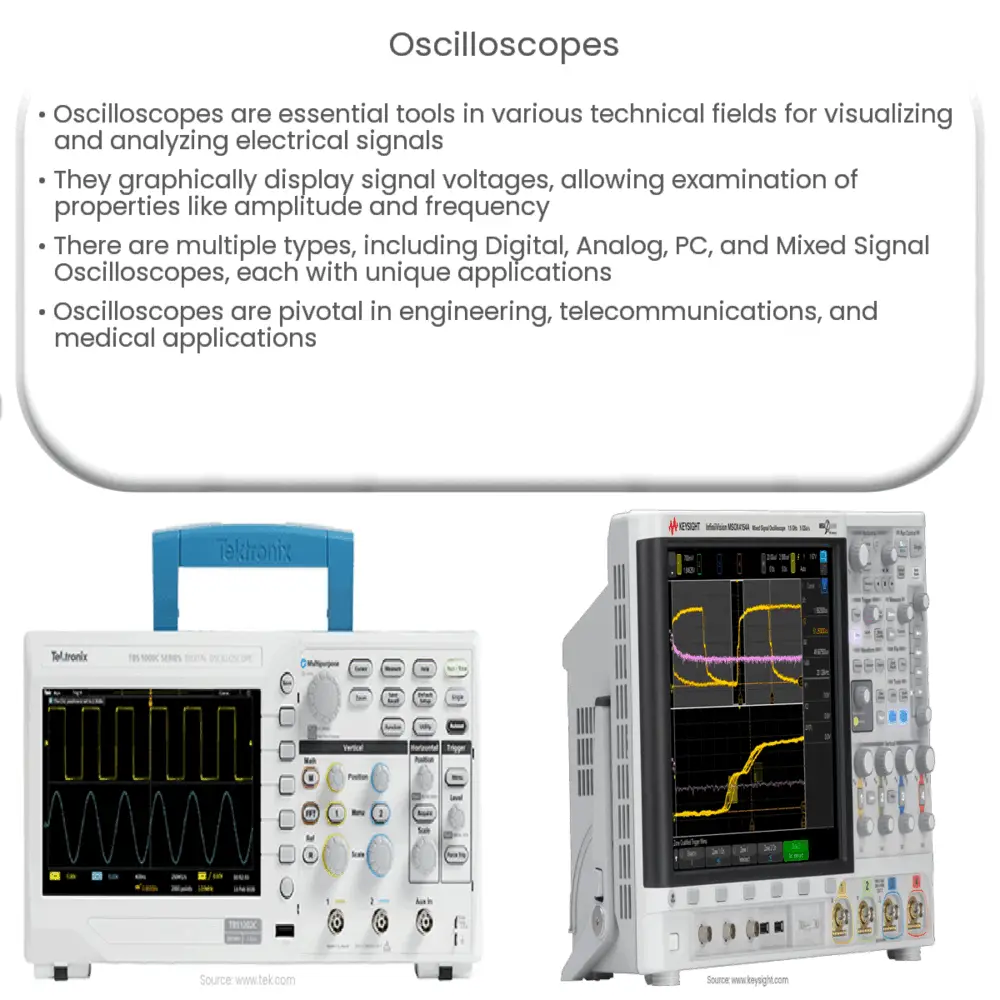Explore the world of oscilloscopes, their types, uses across various industries, and how they work, in this comprehensive guide.

Introduction to Oscilloscopes
An oscilloscope is an essential tool used in a multitude of technical fields. From engineering to healthcare and beyond, the ability to visualize and analyze electrical signals is fundamental to various applications.
What is an Oscilloscope?
An oscilloscope, often referred to as an ‘O-scope’, is a device that graphically displays varying signal voltages. Traditionally, it draws a graph of an electrical signal, with voltage on the vertical Y-axis and time on the horizontal X-axis. This visual representation allows users to examine the properties of the signal such as amplitude, frequency, periodicity, noise, and other phenomena.
Types of Oscilloscopes
There are several types of oscilloscopes, each designed to meet a specific set of needs.
- Digital Storage Oscilloscope (DSO): A DSO captures and stores digital copies of waveforms. It offers superior performance and complex signal analysis.
- Analog Oscilloscope: An analog oscilloscope is the most basic type. It uses a phosphor screen to display signals. It’s best suited for simple, low-frequency applications.
- PC Oscilloscope: A PC oscilloscope uses a computer’s processing power and screen to display readings. This kind of oscilloscope is portable and typically less expensive.
- Mixed Signal Oscilloscope (MSO): An MSO combines the functions of a DSO with a logic analyzer. It can display digital and analog signals simultaneously.
Oscilloscope Applications
Oscilloscopes are widely used in a range of disciplines. Let’s explore some of the primary applications.
- Engineering: Oscilloscopes are fundamental in electrical engineering for analyzing circuit performances.
- Telecommunications: In the telecommunications industry, oscilloscopes help to test and troubleshoot signal quality.
- Medical Applications: Medical devices such as ECG and EEG machines use oscilloscope technology to monitor heart and brain activities.
Clearly, oscilloscopes play a pivotal role in our modern world, underpinning many of the technologies and systems we rely on every day. In the next section, we’ll delve deeper into how oscilloscopes work, how to use them, and their importance in more advanced technical applications.
How Does an Oscilloscope Work?
Oscilloscopes work by first converting the input signal into an electrical voltage. The vertical amplifier then scales this voltage, and it’s subsequently transformed into a vertical position on the screen. Horizontal deflection is governed by a sweep circuit, allowing time to be displayed along the X-axis.
Using an Oscilloscope
Using an oscilloscope may seem daunting at first, but once you understand the basics, it becomes a powerful tool. Here are the fundamental steps:
- Connecting the Probe: The probe is typically connected to the device under test (DUT) and the input channel of the oscilloscope.
- Setting the Time Base: This controls the speed of the sweep across the screen, effectively setting the scale of the X-axis (time).
- Setting the Vertical Scale: This sets the scale of the Y-axis (voltage).
- Adjusting the Trigger: The trigger sets the start point for the sweep, allowing the user to stabilize repetitive waveforms.
Advanced Oscilloscope Applications
Oscilloscopes are not only limited to basic signal visualization; they also offer advanced analysis capabilities.
- Fourier Analysis: Oscilloscopes can perform a Fourier transform to display the frequency components of a signal.
- Protocol Analysis: Digital oscilloscopes can decode and display communications protocols, aiding in the debugging of digital systems.
- Waveform Math: Oscilloscopes can perform mathematical operations on waveforms, such as addition, subtraction, multiplication, and integration.
Conclusion
In conclusion, the oscilloscope is a vital instrument in many industries, including engineering, telecommunications, and healthcare. Its ability to visualize and analyze electrical signals makes it an indispensable tool for debugging and testing electronic systems. From the basic analog oscilloscopes to advanced digital storage oscilloscopes, these devices help facilitate a deeper understanding of the complex world of electronics. As technology continues to evolve, so too will the capabilities and applications of oscilloscopes, further highlighting their importance in our technological landscape.

